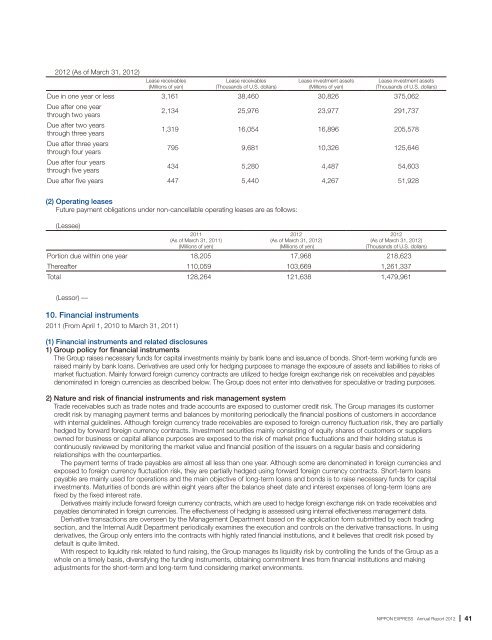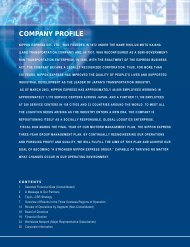Annual Report 2012
Annual Report 2012
Annual Report 2012
You also want an ePaper? Increase the reach of your titles
YUMPU automatically turns print PDFs into web optimized ePapers that Google loves.
<strong>2012</strong> (As of March 31, <strong>2012</strong>)Lease receivables(Millions of yen)Lease receivables(Thousands of U.S. dollars)Lease investment assets(Millions of yen)Lease investment assets(Thousands of U.S. dollars)Due in one year or less 3,161 38,460 30,826 375,062Due after one yearthrough two years2,134 25,976 23,977 291,737Due after two yearsthrough three years1,319 16,054 16,896 205,578Due after three yearsthrough four years795 9,681 10,326 125,646Due after four yearsthrough five years434 5,280 4,487 54,603Due after five years 447 5,440 4,267 51,928(2) Operating leasesFuture payment obligations under non-cancellable operating leases are as follows:(Lessee)2011(As of March 31, 2011)(Millions of yen)<strong>2012</strong>(As of March 31, <strong>2012</strong>)(Millions of yen)<strong>2012</strong>(As of March 31, <strong>2012</strong>)(Thousands of U.S. dollars)Portion due within one year 18,205 17,968 218,623Thereafter 110,059 103,669 1,261,337Total 128,264 121,638 1,479,961(Lessor) —10. Financial instruments2011 (From April 1, 2010 to March 31, 2011)(1) Financial instruments and related disclosures1) Group policy for financial instrumentsThe Group raises necessary funds for capital investments mainly by bank loans and issuance of bonds. Short-term working funds areraised mainly by bank loans. Derivatives are used only for hedging purposes to manage the exposure of assets and liabilities to risks ofmarket fluctuation. Mainly forward foreign currency contracts are utilized to hedge foreign exchange risk on receivables and payablesdenominated in foreign currencies as described below. The Group does not enter into derivatives for speculative or trading purposes.2) Nature and risk of financial instruments and risk management systemTrade receivables such as trade notes and trade accounts are exposed to customer credit risk. The Group manages its customercredit risk by managing payment terms and balances by monitoring periodically the financial positions of customers in accordancewith internal guidelines. Although foreign currency trade receivables are exposed to foreign currency fluctuation risk, they are partiallyhedged by forward foreign currency contracts. Investment securities mainly consisting of equity shares of customers or suppliersowned for business or capital alliance purposes are exposed to the risk of market price fluctuations and their holding status iscontinuously reviewed by monitoring the market value and financial position of the issuers on a regular basis and consideringrelationships with the counterparties.The payment terms of trade payables are almost all less than one year. Although some are denominated in foreign currencies andexposed to foreign currency fluctuation risk, they are partially hedged using forward foreign currency contracts. Short-term loanspayable are mainly used for operations and the main objective of long-term loans and bonds is to raise necessary funds for capitalinvestments. Maturities of bonds are within eight years after the balance sheet date and interest expenses of long-term loans arefixed by the fixed interest rate.Derivatives mainly include forward foreign currency contracts, which are used to hedge foreign exchange risk on trade receivables andpayables denominated in foreign currencies. The effectiveness of hedging is assessed using internal effectiveness management data.Derivative transactions are overseen by the Management Department based on the application form submitted by each tradingsection, and the Internal Audit Department periodically examines the execution and controls on the derivative transactions. In usingderivatives, the Group only enters into the contracts with highly rated financial institutions, and it believes that credit risk posed bydefault is quite limited.With respect to liquidity risk related to fund raising, the Group manages its liquidity risk by controlling the funds of the Group as awhole on a timely basis, diversifying the funding instruments, obtaining commitment lines from financial institutions and makingadjustments for the short-term and long-term fund considering market environments.NIPPON EXPRESS <strong>Annual</strong> <strong>Report</strong> <strong>2012</strong>41





![Business Report for the 102nd Term [PDF 718KB] - Nippon Express](https://img.yumpu.com/46285896/1/184x260/business-report-for-the-102nd-term-pdf-718kb-nippon-express.jpg?quality=85)
![CSR Report 2010 [PDF 5764KB] - Nippon Express](https://img.yumpu.com/45662405/1/184x260/csr-report-2010-pdf-5764kb-nippon-express.jpg?quality=85)






